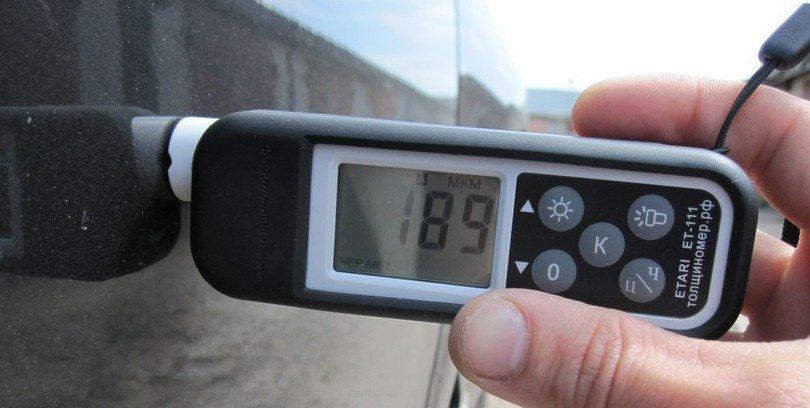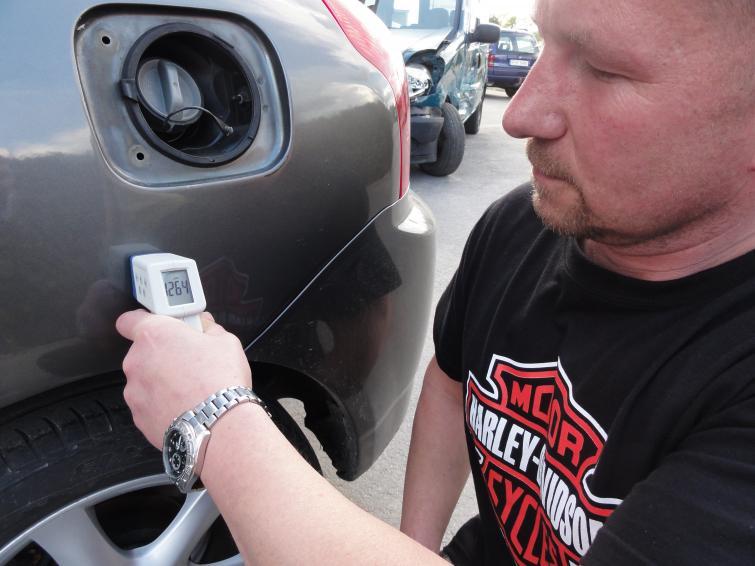
Thickness paint measurer. How to use it and interpret the results?
 In a European-made car, the original paint layer should have a maximum of about 150 microns. In Japanese and Korean cars, a little less. This can be determined with a paint probe - we'll show you how to use it.
In a European-made car, the original paint layer should have a maximum of about 150 microns. In Japanese and Korean cars, a little less. This can be determined with a paint probe - we'll show you how to use it.
Measuring paint thickness is a good way to initially determine if a used car has had a car in the past. With increasingly affordable prices, these meters are widely available and readily used. However, in order for them to pass the test, the device must be correctly selected and used correctly. We suggest how to do it.
Paint thickness is less on cars from Asia
 The thickness of the varnish layer is measured in micrometers (one millionth of a meter is the symbol micron).). Modern cars are usually covered with several layers of protection and varnish. At the factory, steel is usually protected with a layer of zinc, then a primer, and then paint is applied to it. For greater durability and an attractive appearance, the whole thing is covered with a colorless varnish.
The thickness of the varnish layer is measured in micrometers (one millionth of a meter is the symbol micron).). Modern cars are usually covered with several layers of protection and varnish. At the factory, steel is usually protected with a layer of zinc, then a primer, and then paint is applied to it. For greater durability and an attractive appearance, the whole thing is covered with a colorless varnish.
– The thickness of the original paintwork is not the same on all vehicles. Asian-made cars, such as Hyundai, Honda and Nissan, are painted in a thinner layer - in the region of 80 microns - 100 microns. European grades are painted thicker and here the lacomer will show approximately 120-150 or even 170 microns. The exception will be made in Europe after 2007, which are covered with water-based varnishes, in which case the layer may be slightly thinner. Varnishers define a difference of about 20-40 microns. So 120 µm on a Volkswagen or Audi shouldn't come as a surprise either,” explains Emil Urbanski from Blue Technology, a manufacturer of paint thickness gauges.
See also: Spring car cosmetics. Paint, chassis, interior, suspension
It is assumed that the layer of metallic paint is always slightly thicker. In the case of acrylic lacquers, eg standard white or red without a clear coat, the factory default setting is approximately 80-100 µm. The coating inside the elements is typically about 40 microns thinner.
Can the thickness of the varnish be different on individual elements of a car that has not been in an accident? Yes, but the differences may not be very clear cut. It is assumed that the correct deviation between the elements is a maximum of 30-40 percent of the thickness. A 100% thicker coat means you can be almost 350% sure the item has been recoated. If the thickness exceeds 400-XNUMX microns, it should be assumed that the car was puttied at this point. It is worth remembering that car manufacturers reserve the right to repaint the car at the factory, for example, in the event of defects during quality control.
Step by step paint thickness measurement
Clean the bodywork before handling the paint thickness gauge.
 Measure the thickness of the paint on a clean car, because a thick layer of dirt will distort the result. It is best to start with the roof, because this is the element that is least susceptible to damage. This is usually the best reference point for further measurements. Apply a paint thickness gauge to the roof in several places - both in the middle and along the edges. The measurement results are especially important because the roof is damaged in severe accidents.
Measure the thickness of the paint on a clean car, because a thick layer of dirt will distort the result. It is best to start with the roof, because this is the element that is least susceptible to damage. This is usually the best reference point for further measurements. Apply a paint thickness gauge to the roof in several places - both in the middle and along the edges. The measurement results are especially important because the roof is damaged in severe accidents.
- We measure the car as a whole. If the measurement is good at one end of the door, it is worth checking the other end, because here the varnisher may have reduced the difference in shade after repairing the adjacent element. And this is happening more and more often. For example, if the rear door is damaged, it is completely painted, but the front door and rear fender are partially painted, explains Artur Ledniewski, an experienced painter from Rzeszow.
Also Read: Car Purchase Agreement. How to avoid pitfalls?
It is also worth measuring the coating on the pillars and sills, which are much more difficult to replace after a collision than, for example, a door or hood. We measure inside and out. Damage to the roof and pillars will practically disqualify the car as it indicates a serious collision. In turn, thresholds are often repaired due to corrosion. This should also give the potential buyer food for thought.
In order for the measurement to be reliable, it should be performed using a meter with an appropriate probe. - So with the tip that we touch the varnish. Ideally, it should be connected to the meter with a cable. Then we hold the display in one hand, and the probe in the other. This solution eliminates vibrations,” says Emil Urbanski. He adds that the best probes are those with a spherical probe tip that can be accurately applied to an oval element. “This cannot be done with a flat-ended probe, which can also measure incorrectly when, for example, there is a grain of sand between it and the varnish,” says the specialist.
Lacquer gauge – different for steel, aluminum and plastic
 A professional paint gauge that measures the coating on steel bodies can be purchased for around PLN 250. - The most important thing is that he has a probe on the cable. Also, look for gauges with a springy head and a spherical end that make it easier to measure oval and convex features. In this case, the traditional probe may not work, Urbansky explains.
A professional paint gauge that measures the coating on steel bodies can be purchased for around PLN 250. - The most important thing is that he has a probe on the cable. Also, look for gauges with a springy head and a spherical end that make it easier to measure oval and convex features. In this case, the traditional probe may not work, Urbansky explains.
It is important to note that a different gauge is used for the aluminum body, where the paint thickness cannot be measured with a conventional gauge (the steel gauge cannot see the aluminum surface). Such a varnish sensor will cost PLN 350-500. Such a meter detects aluminum elements by indicating the type of substrate on the display.
See also: Dual mass wheel, turbo, and injection How to reduce the risk of modern diesel engine failure?
The most expensive are the lacquer thickness gauges on plastic elements, used, for example, by French manufacturers (including the front fenders in the Citroen C4). “This machine works similarly to an ultrasound machine and requires a conductive gel. However, prices are still very high, exceeding PLN 2500. Therefore, few people buy such equipment yet,” says Urbanski.
